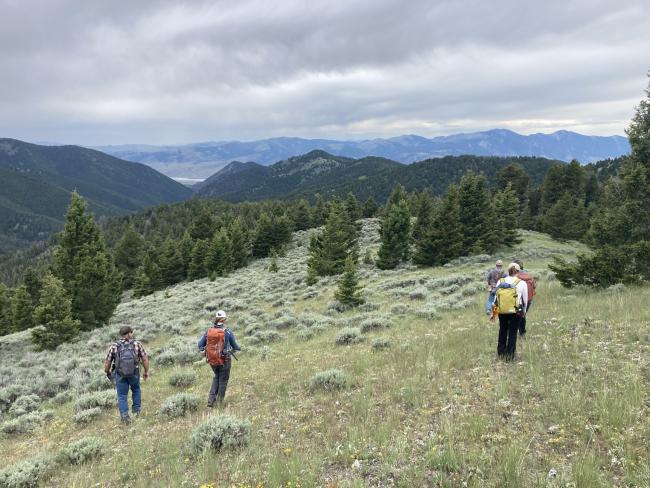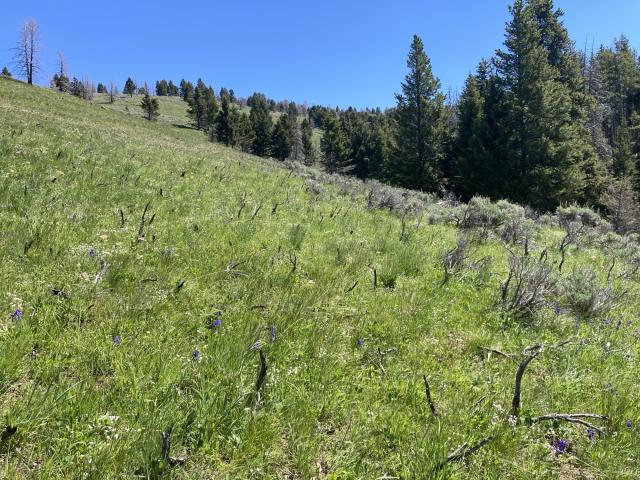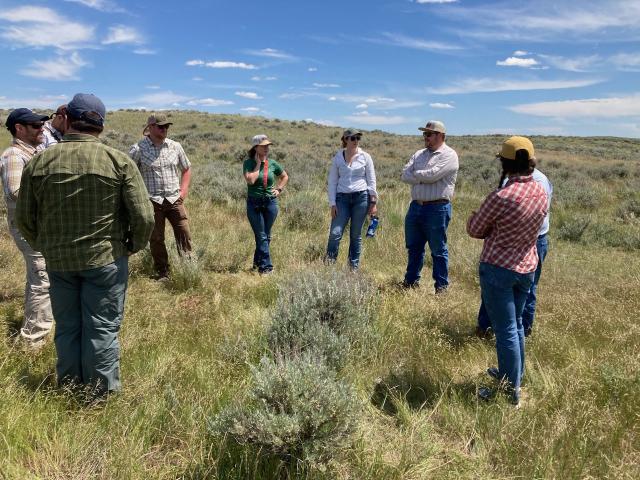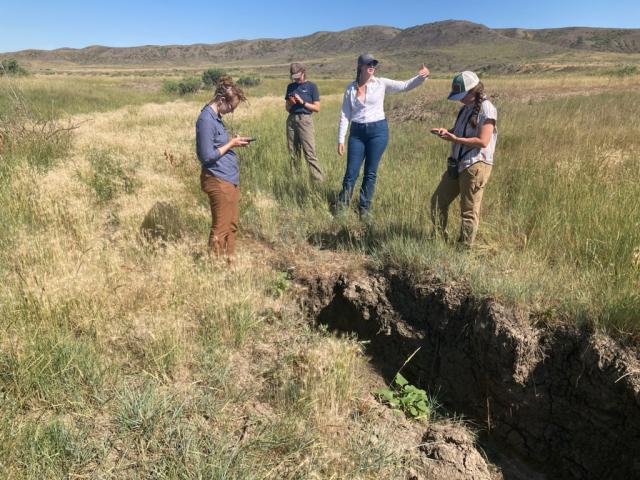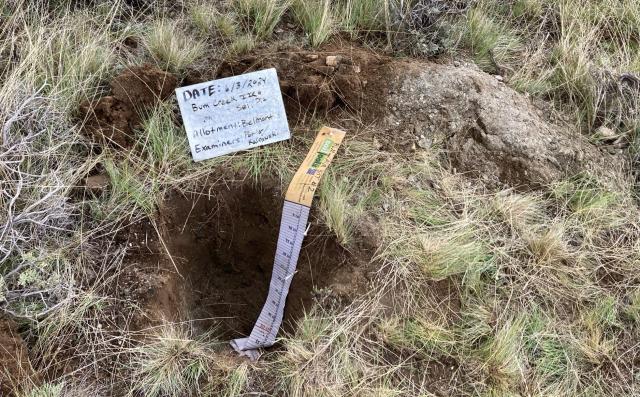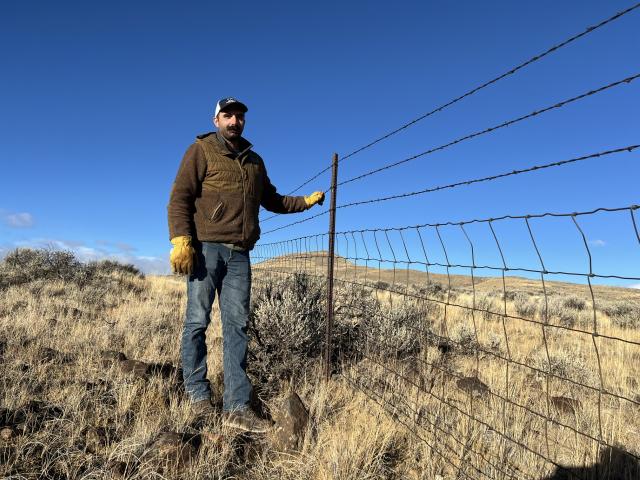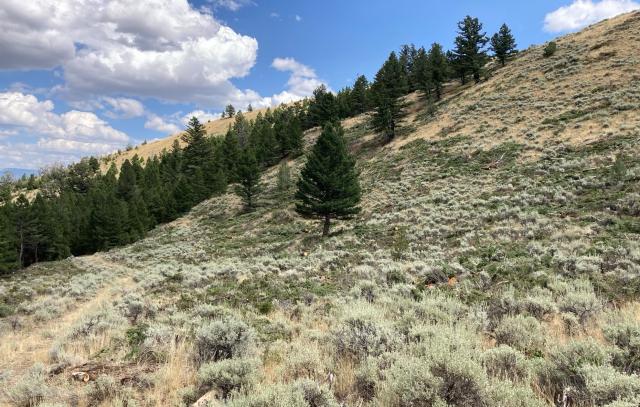Podcast: Partnership fills skills gaps and creates conversations in Montana
Listen
Subscribe
Related Content
In 2023, BLM announced an interagency agreement with the Intermountain West Joint Venture to improve sagebrush ecosystems. One year later, we take a look at what IWJV is doing with some of the funding in Montana. We interview two partners who are working on opposite ends of the state to fill skills gaps and encourage conversations with partners.
Transcript
Transcript: BLM-IWJV Partnership fills skills gaps and creates conversations in Montana
NARRATOR [David Howell, Senior Communications Specialist]: In 2023, the Bureau of Land Management announced its intent to invest in sagebrush restoration through a $4.5 million interagency agreement to the Intermountain West Joint Venture, or IWJV. Today we’re taking a look at what IWJV is doing on projects in one western state: Montana.
I’m David Howell, and this is “On The Ground: A Bureau of Land Management Podcast.” The Intermountain West Joint Venture is one of 18 Joint Venture consortiums in the United States set up by the U.S. Fish & Wildlife Service and aimed at improving habitats for migratory birds and other species. For a significant percentage of BLM lands, this means strengthening and growing core sagebrush ecosystems to benefit sage grouse. And it doesn’t just benefit birds – these habitat projects also help big game and other wildlife species.
Mandi Hirsch is IWJV’s Sagebrush Conservation Coordinator. She said that the investment of funds from the Inflation Reduction Act builds on a long-standing partnership with BLM.
Mandi Hirsch: And then we've already had like a nine-year partnership with the Bureau of Land Management. And so our primary goal was to provide capacity, added boots on the ground for the BLM and those restoration landscapes. We took a deep dive into looking at which landscapes really met our objectives as a JV [joint venture] and also our work under our “partnering to conserve sagebrush rangelands” effort with the BLM and so we chose hiring capacity positions in 13 of the Restoration Landscapes. And through kind of some scoping and additional work with BLM, we've actually hired 11 Restoration Landscape capacity positions out of those 13.
David Howell: And what I was interested in was that, I think you've hired them so that they sit…Actually, they're working with BLM, but you know, they're kind of tied to some other partner out there, right?
Mandi Hirsch: Lots of our capacity positions actually are funded by BLM. They either sit in the BLM office or they sit in a partner office as well. But the main reason why these positions are so unique is that then they can actually, like, work across jurisdictional boundaries. They not only have the ability to work on BLM public lands and work, you know, throughout those larger landscapes, but then they can also bring in, like, state land efforts and private land efforts as well. So, it is a unique approach to conservation because they are able to work across those landscapes and get pretty large-scale coordination, implementation of conservation restoration projects done.
NARRATOR: For BLM, these additional positions from IWJV’s partners are helping to fill gaps in the workforce or provide special skills. They are also expanding the conversation with outside organizations and with private landowners who live near public lands. In Northern Montana, in the town of Malta, IWJV partnered with Ranchers Stewardship Alliance, which has been working with local ranchers and government organizations for more than 20 years. RSA hired Grace Hershberg as a Restoration Landscape Manager.
Grace Hershberg: We have really great ranchers in this area who are interested in doing conservation work, and when you think about ranching and you think about conservation, they are not separate. You know, if you are a rancher, you need to have good grass. You need to have a good habitat for your cattle and you need to have forage for them, and so they're not mutually exclusive. And a lot of the ranchers we work with realize that. And I think a lot of the folks here are learning to do things differently. You know, we talk a lot with ranchers about how their grandma and grandpa used to do it one way, but now they're starting to look at things differently because they need to find ways to continue to be profitable and stay on this landscape. And a lot of times, that means that we need to be treating our land really well, as well.
NARRATOR: Grace understands that not being a BLM employee can have some advantages when conversing with ranchers. For one thing, she doesn’t have decision authority over how many head of cattle they can run on public lands.
Grace Hershberg: And so, to be able to come from a position where I might be able to help producers on their BLM allotments, but I'm not necessarily a BLM employee, can sometimes ease a little bit of that fear, I think. The great thing, too, about this position and the people we work with is that the folks at RSA have been doing this, have been working with ranchers, for 20-plus years at this point. Like, we are a rancher-led organization; ranchers are our priority. And so being able to work with them and then be able to help translate that to some of the BLM side I think is super-beneficial and helpful.
Matt Comer: In rural Montana, partnerships are everything.
NARRATOR: That’s Matt Comer, a BLM Project Manager in Glasgow, Montana, who is working with Grace Hershberg. For Matt, one of the most important things is keeping the lines of communication open with the landowners and grazing permittees, including when he and other BLM staff are planning sagebrush restoration projects.
Matt Comer: Ranchers Stewardship Alliance and Grace have already built some of that trust up, and she's helped facilitate having some field trips out to look at some potential prescribed burns and to look at some other areas that we've already burned to be able to showcase, you know, “here's what we're trying to do just north of the river; so, here's what it will look like,” and it's really helped when you can see what's being proposed that's already been implemented somewhere else, so that you have more comfort with it and you can see what the process is like and be able to ask those questions. So, it really does help with that transparency and trust.
NARRATOR: On the other side of the state, in BLM’s Dillon, Montana Field Office, Project Manager Cory Manseau is using the Intermountain West Joint Venture position in a similar way to talk with landowners, but also to fill a critical skills gap in the workforce.
Cory Manseau: It was initially kind of presented as a kind of a partner coordinator position and we kind of expanded on that with looking for a person that had some soil science expertise just to help guide some of the restoration ideas that we that we have and want to execute. So, we were able to get a very good candidate: his name is Ethan Kalinowski, and he was actually a district soil conservationist with the NRCS up in Conrad. So he has a tremendous amount of soils expertise and then just a lot of experience dealing with private land owners and other federal agencies, state entities.
Our landscape level conservation approach is it's not just strictly tied to BLM, it's that we're looking across land ownership to try to do these restoration projects on all ownerships and kind of tie it all together to just improve the overall landscape level health.
Ethan Kalinowski: It is a unique position and I tell you for BLM, I can help them in several different ways.
NARRATOR: This is Ethan Kalinowski. After working for the Natural Resources Conservation Service, Ethan now works for Pheasants Forever, a conservation group whose focus is on habitat improvements for game birds. He sits with BLM staff in Dillon as a member of their interdisciplinary team, offering advice based on his experience as a soils scientist and a biologist.
Kalinowski: Number one, I can work outside those sort of public land boundaries. That's something they've already been trying to do in this area, but there's great opportunities right down here out of Dillon with the Southwest Montana Sagebrush partnership. They've been phenomenal at working across boundaries, but they don't have somebody in their BLM office that has been dedicated to that. But I can be that person. So I'm trying to accomplish those goals for the BLM.
And then for Pheasants Forever, they have never had a presence down here in Southwest Montana at all. So I can kind of expand their mission down here, and I know that's a goal; they just are trying to get a foothold. And as far as Pheasants Forever is concerned, I am not concerned with or working directly with just pheasants. You know, they are trying to establish themselves as a habitat organization. And not just tied to their name of “Pheasants.” It's an easy way to get some education out there and pass on the message from Pheasants Forever that “hey, we're here to help.” NGO's [Non-governmental organizations] can kind of operate in gray areas that, you know, the BLM can't, so use me to accomplish goals that you can't accomplish other ways.
NARRATOR: For Mandi Hirsch at the Intermountain West Joint Venture, the addition of BLM funding on projects throughout the west is an opportunity to demonstrate the interconnection between public and private lands and owners, and that it’s not just BLM working on restoration.
Mandi Hirsch: Not only is the BLM our primary partner in this effort, but we also have over 600 other partners that are true advocates and really involved in the day-to-day efforts of these partner positions and this “partnering to conserve sagebrush rangelands” effort. So without them, right, this doesn't happen. And so not only does the BLM bring additional funding for these positions, but numerous state, local partners also provide funding and local support and leadership for these positions. So it's a combined effort out there, and we're just hoping that, like I said, it continues to grow.
NARRATOR: Mandi Hirsch is the Sagebrush Conservation Coordinator for the Intermountain West Joint Venture. She joined us from her home in Crowheart, Wyoming. Thanks also to Grace Hershberg from Ranchers Stewardship Alliance in Malta, Montana; Matt Comer from BLM’s Glasgow, Montana Field Office; Ethan Kalinowski from Pheasants Forever in Dillon, Montana; and Cory Manseau from the BLM Dillon Field Office.
If you’re interested in learning more about how BLM is partnering with IWJV, you can find more information at partnersinthesage.com. We’ll also have links from this episode at BLM.gov/media/podcasts, where you can find all our “On The Ground” episodes.
I’m David Howell, and we’ll see you out there, “On The Ground.”

